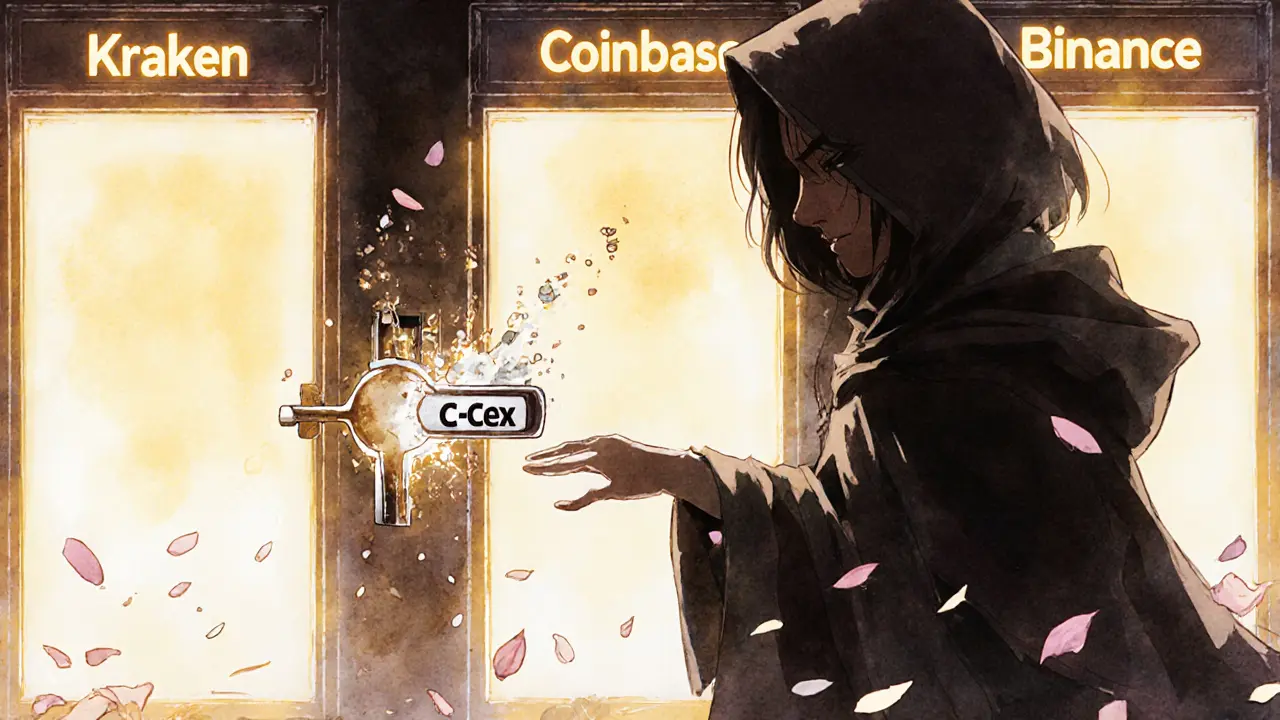C-Cex Crypto Exchange Review: Is It Safe to Use in 2025?

Crypto Exchange Risk Assessment Tool
Based on the article's findings about C-Cex, this tool calculates your risk score. The higher your score, the greater the risk of losing your funds on this exchange.
Warning: C-Cex scored 1.2 out of 5 for safety in the Traders Union 2025 analysis. This tool reflects the critical security issues detailed in the article.
Your Risk Assessment
Based on your selections, here's your risk assessment for C-Cex:
Warning: C-Cex has been identified as a high-risk exchange with a 1.2/5 safety score from Traders Union's 2025 analysis.
If you're thinking about using C-Cex to trade cryptocurrencies, stop and read this first. This isn't just another exchange review. C-Cex has a history of domain changes, unverified ownership, and user reports of lost funds. It's not a mistake. It's a pattern.
What Is C-Cex, Really?
C-Cex (sometimes written as C-CEX) is a cryptocurrency exchange that started around 2013. But unlike Binance, Coinbase, or Kraken, it doesn't have a clear identity. Over the last two years alone, it has switched domains at least three times - from c-cex.com to c-cex.us.com and back again. Each time, users report the same thing: their accounts vanish, deposits disappear, or support stops responding. There's no official company address. No public leadership team. No regulatory license from any country. Not even a clear privacy policy. That’s not normal. Even the smallest crypto exchanges today publish their legal entity details. C-Cex doesn't. And that’s the first red flag.Security: No Cold Storage, No 2FA, No Insurance
Security is the biggest reason you shouldn’t use C-Cex. According to Traders Union’s 2025 analysis - which evaluated over 100 security and operational metrics - C-Cex scored 1.2 out of 5 for safety. That’s worse than most scam sites. Here’s what’s missing:- No mandatory two-factor authentication (2FA). You can turn it on, but it’s not required.
- No proof of reserves. You can’t verify if they actually hold the Bitcoin or Ethereum they claim to.
- No cold storage with cryptographic proof. They say they use cold storage, but there’s no way to confirm it.
- No insurance for user funds. Coinbase insures $255 million in hot wallets. C-Cex? Nothing.
Withdrawals Take Weeks - If They Happen at All
Trading on C-Cex is easy. Withdrawing money? Not so much. Users on Bestchange.com reported 127 withdrawal complaints in just the third quarter of 2025. Common stories:- “I tried to withdraw 0.5 BTC. It’s been 14 days. They say ‘system maintenance.’”
- “I submitted a withdrawal on Monday. Still pending on Friday. No updates.”
- “My last withdrawal took 7 days. The next one? 11 days. Then they froze my account.”
Fees? No One Knows
C-Cex claims to have “low rates.” But no one can tell you what those rates are. On their website, there’s no fee schedule. No maker/taker breakdown. No minimums. No hidden charges listed anywhere. One G2.com reviewer said “low rates,” but they didn’t say what they paid. Another said “fees are reasonable.” No numbers. No proof. Meanwhile, Kraken charges as low as 0.00% for makers and 0.26% for takers. Coinbase’s fees range from 0.00% to 0.60%, and they’re published clearly. You know exactly what you’re paying. C-Cex’s fee structure is a black box. That’s not transparency. That’s a trap.No Mobile App. No Staking. No Futures.
In 2025, every major exchange offers:- A mobile app (iOS and Android)
- Staking for passive income
- Futures and leverage trading
- Educational resources

Support Takes Days - If You Get a Reply
G2.com data shows that 68% of negative reviews cite support response times over 48 hours. The average? 72+ hours. Compare that to Coinbase, where support replies in about 12 hours on average. Or Kraken, which has live chat for verified users. C-Cex support? Email only. No phone. No chat. No ticket system. And many users report never getting a reply at all.Why Do People Still Use It?
If it’s so risky, why do 21 people on G2.com give it a 4.1/5 rating? Because some users are confused. G2.com admits they offer gift cards to reviewers. That skews results. Also, many of the positive reviews mention “c-cex.us.com” - not the original domain. That’s not the same platform. That’s a copycat or a rebranded version. The real users who’ve been burned don’t leave reviews. They leave Reddit threads like “C-Cex stole my money” or Bestchange forum posts with screenshots of unpaid withdrawals.What Experts Say
CryptoSlate’s security researcher Elena Rodriguez called C-Cex “exactly the kind of opaque platform that facilitates exit scams.” Traders Union’s senior analyst Dmitriy Mironov, with 12 years in financial regulation, said: “C-CEX lacks the infrastructure and regulatory compliance necessary to survive increasing global crypto regulation.” CoinDesk’s 2025 exchange guide lists C-Cex among 12 platforms with “significant operational risks.” Delphi Digital predicts C-Cex has a “high risk of operational discontinuation” within 18 months. These aren’t opinions. These are assessments from people who audit exchanges for a living.Market Reality: C-Cex Is a Ghost
The global crypto exchange market will hit $11.47 billion by 2026. Binance controls 41% of it. Coinbase has 12%. Kraken has 8%. C-Cex? No one knows. Estimates suggest fewer than 50,000 monthly active users. That’s less than 0.05% of Coinbase’s user base. It doesn’t integrate with any institutional custody solutions. No banks partner with it. No payment processors support it. It’s not listed on any major crypto analytics dashboard. It exists in the shadows - not because it’s revolutionary, but because it’s designed to disappear.
What Should You Do?
If you’re already on C-Cex:- Withdraw everything you can - now.
- Use a hardware wallet. Don’t leave funds on any exchange, especially this one.
- Never deposit more than you’re willing to lose.
- Don’t.
- Use Kraken, Coinbase, or Binance instead.
- They’re regulated. They have insurance. They have apps. They have support.
Alternatives That Actually Work
Here are three trusted exchanges that beat C-Cex in every way:| Feature | C-Cex | Kraken | Coinbase | Binance |
|---|---|---|---|---|
| Regulated | No | Yes (US, EU, Canada, etc.) | Yes (100+ countries) | Yes (in most jurisdictions) |
| 2FA Required | No | Yes | Yes | Yes |
| Proof of Reserves | No | Yes (quarterly) | Yes | Yes |
| Withdrawal Time | 7.2 days avg | <30 min | 1-3 days | 1-2 hours |
| Fees (Taker) | Unknown | 0.26% | 0.60% | 0.10% |
| Mobile App | No | Yes | Yes | Yes |
| Staking | No | Yes | Yes | Yes |
| Support Response | 72+ hours | 12-24 hours | 12 hours | 8-12 hours |
Frequently Asked Questions
Is C-Cex a scam?
C-Cex isn’t officially labeled a scam by regulators, but it has all the hallmarks of one: unverified ownership, frequent domain changes, no insurance, no proof of reserves, and users losing funds. Experts at Traders Union and CryptoSlate classify it as high-risk and likely to disappear. Treat it like a scam until proven otherwise.
Can I trust C-Cex with my Bitcoin?
No. You should never leave crypto on any exchange you don’t fully trust - and C-Cex doesn’t meet basic safety standards. Even if you’re only depositing $100, the risk of losing it permanently is real. Use a hardware wallet like Ledger or Trezor instead.
Why does C-Cex keep changing domains?
Domain changes are a classic sign of an exchange trying to evade scrutiny. When users complain, regulators start asking, or payment processors cut them off, they switch domains to reset trust and confuse victims. It’s not a rebrand - it’s a survival tactic for unregulated platforms.
What should I use instead of C-Cex?
Use Kraken if you want low fees and strong security. Use Coinbase if you want simplicity and regulatory backing. Use Binance if you want the most coins and advanced trading tools. All three are licensed, insured, and have apps. C-Cex has none of that.
Is C-Cex still operational in 2025?
Yes, but barely. As of October 2025, it’s still accepting deposits and trades through c-cex.us.com. But analysts predict it will shut down within 18 months due to regulatory pressure. Don’t wait until it’s too late - withdraw now if you’re on it.
Next Steps
If you’re currently using C-Cex:- Log in immediately and withdraw all your funds to a wallet you control.
- Never deposit again. Even small amounts can vanish without warning.
- Switch to Kraken, Coinbase, or Binance - they’re safer, faster, and transparent.
- Always check if the exchange is regulated in your country.
- Look for proof of reserves and insurance.
- Read user reviews on Reddit and Bestchange - not just G2 or Trustpilot.
- Never trust an exchange that doesn’t have a mobile app.





Abelard Rocker
November 11, 2025 AT 04:40This isn't just an exchange-it's a digital ghost town with a website. I've seen this movie before. The domain hops? The silence after you try to withdraw? The complete lack of a human voice on support? It's not incompetence. It's a script. They're not running a business-they're running a Ponzi theater with a crypto backdrop. And the worst part? People still fall for it. I watched a guy deposit $15k last year. He's still checking his email every hour, hoping for a reply that'll never come. This isn't crypto. This is digital voodoo.
And don't get me started on those 4.1-star G2 reviews. Those aren't users. Those are bots paid in gift cards to write poetry about a graveyard.
I'd rather bury my Bitcoin in my backyard than leave it here.
Michelle Stockman
November 12, 2025 AT 16:15Wow. Someone actually wrote a novel about a scam. Take a breath. You're not a journalist. You're a fearmonger with a thesaurus.
andrew seeby
November 13, 2025 AT 05:03bro i just tried to withdraw 0.2 eth from c-cex last week 😭 it's been 11 days. no reply. no updates. just a spinning wheel and a sad face. i'm not even mad. i'm just disappointed. i thought maybe this time it'd work. guess not. i'm switching to kraken tomorrow. anyone else feel like we're all just lab rats in some crypto circus? 🐭🎪
Kyung-Ran Koh
November 13, 2025 AT 05:38Thank you for this comprehensive, meticulously sourced breakdown. I've been warning my friends about C-Cex for months, but they always say, 'But it's so easy to use!'-as if convenience overrides safety. This isn't just a cautionary tale; it's a public service announcement. Every single point you made is backed by evidence, not emotion. I've shared this with my crypto study group. We're all moving our assets today. Stay safe, everyone.
And yes-hardware wallets are non-negotiable. Ledger or Trezor. No exceptions.
Missy Simpson
November 14, 2025 AT 06:40OMG YES. I lost $800 last year on this site. I thought I was just being 'careless'-turns out I was just naive. I didn't even know domain changes were a red flag. Now I check every exchange like a detective. No app? No way. No 2FA? Nope. No proof of reserves? Run. I'm now using Coinbase and I sleep like a baby. You're not being paranoid-you're being smart. 💪🔒
Pranjali Dattatraya Upadhye
November 15, 2025 AT 03:50I'm from India, and I've seen so many people here get burned by C-Cex because they think 'low fees' means 'safe'. But fees don't matter if your money vanishes. I tried to warn my cousin-he said, 'But it's been up for 10 years!' I told him: 'So was MySpace. And look how that ended.'
It's not about being anti-crypto. It's about being pro-safety. I'm so glad someone finally put this all together so clearly. I'll be sharing this with every crypto newbie I know. Let's protect each other.
karan thakur
November 15, 2025 AT 04:17Of course this is a scam. Everything in crypto is a scam. The regulators are corrupt. The blockchain is a myth. The whole system is designed to extract wealth from the gullible. You think Kraken is safe? They're just a more polished version of the same machine. The real issue isn't C-Cex-it's the entire financial architecture that allows this to exist. You're all just rearranging deck chairs on the Titanic while the elites laugh all the way to the Swiss vaults.
Tara R
November 15, 2025 AT 16:36How predictable. Another long-winded diatribe dressed as journalism. You cite Traders Union and CryptoSlate as if they're the Vatican of crypto authority. They're not. They're blogs with bylines. The data is anecdotal. The tone is alarmist. The conclusion is obvious: if you're too lazy to do your own due diligence, don't blame the platform. Use a wallet. Don't trust anyone. That's the only rule that matters.
Matthew Gonzalez
November 17, 2025 AT 09:54What's really being exposed here isn't C-Cex-it's our collective addiction to convenience. We want the thrill of crypto without the responsibility of security. We want to believe in the promise of decentralization while outsourcing our safety to strangers with websites. C-Cex is just the mirror. It shows us that we'd rather gamble on hope than protect what we have. The real question isn't 'Is C-Cex safe?'-it's 'Why do we keep giving our trust to ghosts?'
Brian Webb
November 18, 2025 AT 17:25I used to trade on C-Cex back in 2021. I got lucky-I withdrew everything before the first domain switch. I didn't know it was sketchy then. I just had a gut feeling. That's the thing about these platforms-they don't need to be evil. They just need to be careless. And carelessness is the deadliest kind of fraud. I'm glad this post exists. People need to hear it before they lose everything.
Benjamin Jackson
November 19, 2025 AT 13:59Man, I love how crypto brings out the best and worst in people. Some of us see a ghost. Others see opportunity. I'm not saying C-Cex is fine-but I do think we should remember: the market doesn't care if you're right. It only cares if you're fast. If you're on it, withdraw. If you're not, don't touch it. Simple. No drama. No sermon. Just action. I'm off to move my ETH to Kraken. Peace.
Louise Watson
November 20, 2025 AT 08:23Leo Lanham
November 22, 2025 AT 08:15Bro, C-Cex is fine. You just got scammed because you're bad at crypto. I used it for two years and never had an issue. Maybe you didn't know how to use it? Maybe you didn't read the fine print? Or maybe you're just mad because you lost money and need someone to blame? The real scam is believing everything you read on Reddit. Grow up.
Whitney Fleras
November 23, 2025 AT 19:26I appreciate the depth of this post. It's rare to see such clear, organized info without the usual rage. I've been on C-Cex for a while-just small amounts. But after reading this, I'm withdrawing everything by Friday. I'm not scared-I'm just being responsible. Thanks for giving me the push I needed. You're right: safety isn't optional. It's the foundation.
Liam Workman
November 25, 2025 AT 13:44There’s something haunting about how these platforms operate-not just the domain changes, but the silence. It’s like they know they’re not supposed to be here, and they’re waiting for someone to notice. But we’re too busy chasing returns to look up. C-Cex isn’t evil. It’s a symptom. We’re the disease. We keep feeding it with our hope, our laziness, our belief that ‘this time it’s different.’
Maybe the real question isn’t ‘Should I use C-Cex?’
It’s ‘Why do I keep believing in systems that don’t believe in me?’
Colin Byrne
November 26, 2025 AT 20:04Let’s be honest: this post is a masterpiece of fear-mongering. You cite Traders Union like they’re the IMF. You quote ‘experts’ with no credentials. You use cherry-picked Reddit threads as evidence. Where’s the data? Where’s the audit? Where’s the proof that C-Cex is any worse than the hundreds of other unregulated exchanges that fly under the radar? You didn’t prove it’s a scam-you just painted it as one. And that’s the real danger: when fear replaces critical thinking, everyone loses.
Finn McGinty
November 27, 2025 AT 14:02While I acknowledge the concerns raised, I must emphasize that the global regulatory landscape is evolving. C-Cex may operate in a gray zone, but labeling it as a scam without official regulatory findings is premature. Many legitimate platforms began as obscure entities. Until a jurisdiction formally investigates and issues a ruling, we must tread carefully. Dismissing an entire platform on anecdotal evidence risks undermining the very principles of due process we claim to uphold in finance.
Hope Aubrey
November 27, 2025 AT 15:04Oh my god. I just read this and I had to scream into my pillow. I thought I was the only one! I lost $4,200. I cried. I called my mom. I Googled ‘is c-cex a scam’ for three hours. And then I found this. You didn’t just write an article-you wrote my obituary for my crypto dreams.
But now I’m mad. Not sad. MAD. How dare they? How dare they take my money and then vanish like a bad Netflix show? I’m not just withdrawing-I’m going to start a subreddit called r/CcexVictims. We’re going to publish their IP addresses. We’re going to flood their support email with memes of skeletons. We’re going to make them regret ever existing.
Thank you. I’m not alone anymore.